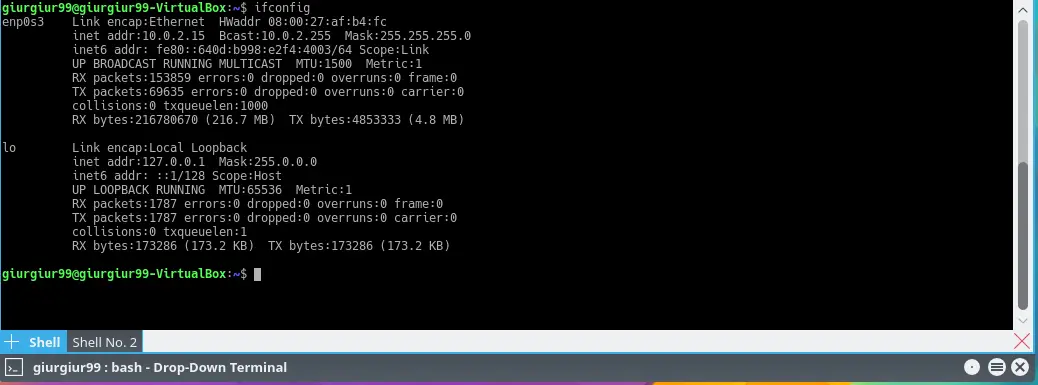While it is true that every day that passes Linux distributions depend less and less on the terminal, it is also true that the use of it is essential at any time so it is almost impossible not to depend on it. There are different terminal emulators with which we can work within our favorite distribution. That is why in this post, we will tell you which are the best Linux terminal emulators.
The terminal (emulator) is a program that simulates the operation of a terminal (physical) of a host computer through a telecommunications network, between the host computer and the computer running the terminal emulator. It is a fairly common application to use but it is always possible to have alternatives that give us an extra in working with it.
Best Linux Terminal Emulators
1) Gnome Terminal
GNOME Terminal is a terminal emulator application for accessing a UNIX shell environment which can be used to run programs available on your system. The Application supports escape sequences that control cursor position and colors.
As you can imagine, it is included in all distributions that use GNOME as the default desktop environment. This includes Ubuntu, Fedora, Linux Mint, OpenSUSE, or other distributions that include GNOME.
So, It can run any application designed for the VT102, VT220, and xterm terminals, accepting all escape sequences used for functions such as course position and screen clearing.
2) Konsole
This terminal is the default terminal inside KDE, this terminal supports multiple tabs, has support for copy, paste, cut, drag text, and more.
As with GNOME Terminal, Konsole is present in any Linux distribution that makes use of Plasma as the desktop environment.
So, Konsole is also integrated into multiple other KDE Applications making it easier to reach and more convenient. For example, KDevelop, Kate, and Dolphin all use Konsole as an integrated terminal emulator.
3) TMUX
With TMUX we have something different because it is a terminal multiplexer. This makes it possible to create several terminals or windows, each running as a separate program, to be created, accessed, and controlled from a single window.
This program is oriented a little more for intensive terminal users such as sysadmin.
On Debian based distributions it can be installed by running
sudo apt install tmux
And in Fedora 33
sudo dnf install tmux
On OpenSUSE:
sudo zypper in tmux
4) Terminator
Among its main features are automatic login, drag and drop text and links, search, horizontal scroll, multiple tabs, number reinterpretation, portability (cross-platform), unlimited scrollback, and more.
Terminator supports multiple terminals at the same time, if so, within the same terminal window we can run and work with another terminal simultaneously. Quite a utility.

So, In distributions based on Debian, you an install it by running
sudo apt install terminator
and in Fedora 33
sudo dnf install terminator
On OpenSUSE:
sudo zypper in terminator
5) Guake
We have already told you about Guake and this terminal emulator allows you to increase productivity when working with the terminal. It is easily deployable by pressing a key.
But that’s not all, it is also customizable and you can make it part of your daily use.
So, In distributions based on Debian, you an install it by running
sudo apt install guake
and in Fedora 33
sudo dnf install guake
On OpenSUSE:
sudo zypper in guake
6) Yakuake
Yakuake is a drop-down terminal emulator for the KDE desktop based on Konsole. So it is created with QT technology. Among its main features we have that it smoothly scrolls down from the top of our screen, supports tabs, size and speed of animations are customizable, supports skins (themes).

So, In distributions based on Debian, it can be installed by running
sudo apt install yakuake
and in Fedora 33
sudo dnf install yakuake
Finally, on OpenSUSE:
sudo zypper in yakuake
7) Pantheon-Terminal
This Terminal emulator is an ElementaryOS emulator but it is one of the best. It has a very modern design that makes it versatile and quite comfortable to work with. Comes with sane defaults, browser-class tabs, sudo paste protection, smart copy/paste, and little to no configuration.
To install it in another distribution that is not ElementaryOS we have to compile the source code manually. The instructions in the Github profile of the application.
Conclusion
Working with the terminal is more comfortable if we have an emulator capable of giving us the best of this world. In this post, we have presented the best Linux emulators so that you can get the most out of each one.
So, do you know other terminal emulators? What do you think of these? Do you think they are the best?